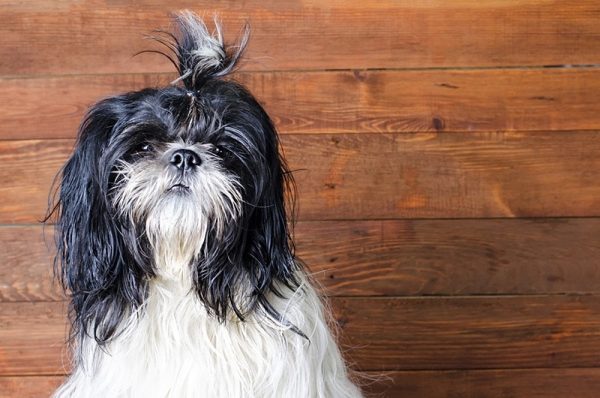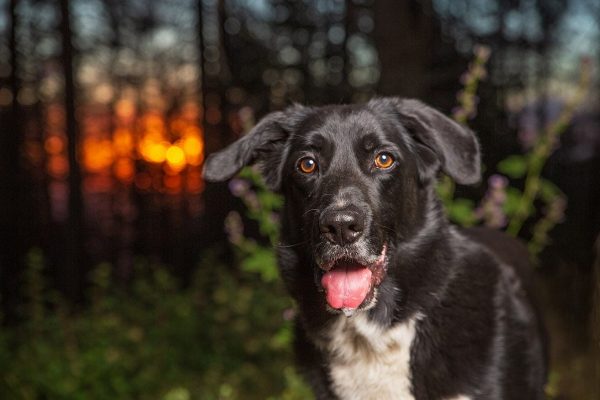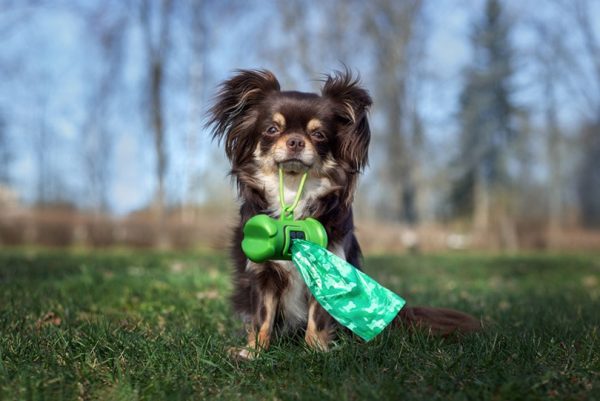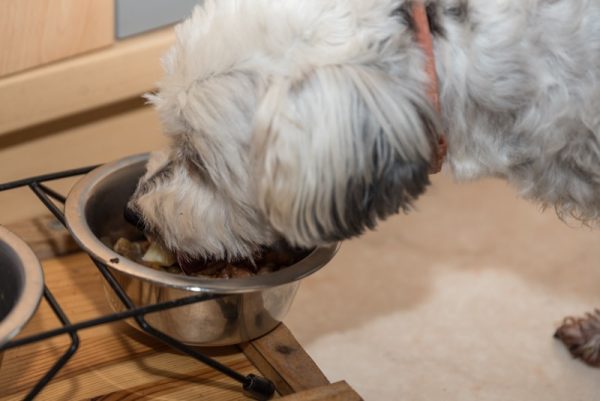In this article
View 8 More +As the name suggests, this breed is a hybrid of a German Shepherd and Great Dane. Because this is a mixed breed, you never know exactly what you’re going to get. They can inherit any trait from any parent. Some may act and look exactly like German Shepherds, or they may look and act exactly like a Great Dane.
Breed Overview
Height:
28–30 inches
Weight:
65–110 pounds
Lifespan:
7–10 years
Colors:
Black, brindle, fawn, harlequin
Suitable for:
Active families with plenty of extra time
Temperament:
Smart, protective, people-oriented
Most will be somewhere in between. However, you are basically playing the dog lottery when you adopt a mixed breed.
The German Shepherd and Great Dane differ a lot. For this reason, their offspring tend to differ a lot as well. However, in this article, we will attempt to outline some of the things you may expect from this playful breed.
German Shepherd Great Dane Mix Characteristics

German Shepherd Great Dane Mix Puppies
These dogs are difficult to find. Typically, there are few breeders that produce them, as they’re not one of the popular “mixed breeds.” However, they can be the result of accidental litters and may be produced by breeders occasionally.
Breeder prices for the German Shepherd Great Dane mix are going to be on the expensive side. This is because breeders typically put a lot of time and money into their dogs. Most get basic vet care before they are adopted, and the parents are typically health tested before breeding. This all leads to more money being spent on the breeder’s end.
You may be able to find them at your local animal shelter, though this will generally be rare. The price will depend on the rescue you purchase them from, as well as the amount of vet care the dog needs after arriving at the shelter. Puppies are usually more expensive than adult dogs.


Temperament & Intelligence of the German Shepherd Great Dane Mix
These dogs are typically quite social and intelligent. The temperament of the Great Dane typically mellows out the German Shepherd a bit. However, the extent varies considerably from dog to dog. Some are quite mellow and very friendly, while others are protective and need more extensive socialization.
Either way, the German Shepherd Great Dane mix tend to be quite intelligent. They will likely need a high level of mental stimulation. This can be accomplished through the use of training and puzzle toys. Some games, like hide-and-seek, also work to provide mental stimulation. We highly recommend getting these dogs involved in some sort of canine sport, such as agility or obedience, as they do best when their mind is provided with a job.
Because of their intelligence and people-pleasing nature, these dogs tend to be very easy to train. They readily listen to their owners and are smart enough to pick up on a wide variety of commands. Given their somewhat protective nature, this is extremely beneficial. While they can be trained by anyone experienced with canines, we recommend group classes simply for the socialization aspect.
Socialization is extremely important for these dogs. Otherwise, they can be wary of strangers and defensive. Their protective instincts aren’t always as strong as a purebred German Shepherd’s, but this is absolutely possible. For this reason, we highly recommend taking them out to socialize extensively from a young age.
As people-oriented dogs, they require a lot of attention. Otherwise, they can become excessively destructive and bored. These aren’t dogs that you can leave home alone for much of the day—not without training and plenty of mental stimulation. Therefore, we only recommend these dogs for people who have plenty of time to pay attention to these canines.
Are These Dogs Good for Families? 👪
Yes, with the proper training, these dogs can be good companion animals for families. They are usually good with children as long as they are socialized with them at a young age. While they are sometimes protective against strangers, this usually doesn’t apply to their children. In fact, these dogs can be utilized as guard dogs in homes with children due to their gentle nature with their people.
They are large enough to avoid injuries due to children and typically are not threatened by children. Most are not scared of toddlers and similar kids, especially if they grow up next to them. While they aren’t as gentle as a Great Dane, they are usually plenty gentle enough for families of all sorts.
Of course, this assumes your German Shepherd Great Dane mix is socialized properly. They should be around children starting at a very young age. Training is important to ensure that they are well-behaved as well. These dogs are very people-oriented and will typically listen to everyone—including the children in their family. However, they can’t listen if they don’t understand what you’re saying.
Does This Breed Get Along With Other Pets? 🐶 😽
Yes, they can. Again, proper socialization is essential. If your dog is never introduced to other dogs at a young age, then they may never get along with other pets. They won’t know how to interact with dogs or other pets and may become fearful or aggressive when you bring another one home later.
However, if your dog is taken around other dogs often, they will learn to interact appropriately and will be fine around them. Of course, due to their protective nature, your dog may not like it when other dogs come into their home. This often means that they will need extra time to warm up to new dogs.
Because of their prey drive, these dogs will not get along well with cats. They will chase them, and there is little socialization can do to fix this. However, some of these dogs are so well-disciplined that they can be taught to sit and stay instead of chasing cats. This involves constant supervision, though. The dog and cat won’t be able to exist peacefully when left to their own devices.

Things to Know When Owning a German Shepherd Great Dane Mix
Food & Diet Requirements 🦴
These dogs do not have any specific nutritional needs. They typically thrive on any high-quality commercial dog food. They aren’t prone to any health problems that require a specific diet either, so most of them don’t need a prescription diet.
We recommend a diet that is high in protein, as these dogs are quite active. Furthermore, you may want to look at a formula that supports their joints. These dogs are prone to some joint problems, and there are a few ingredients that can potentially help with this. Of course, if your dog has any specific health problems, you may want to consider a diet to help with that as well. For instance, skin and coat problems can often be helped with a diet high in omega fatty acids.
These dogs are large, so they need a substantial amount of food. This often means that you’ll spend quite a bit on their diet alone. We recommend carefully budgeting for their food needs due to their size.
Exercise 🐕
Most of the time, these dogs are decently active, but just how active can vary. German Shepherds tend to be very active. Great Danes are a bit more laidback. Their puppies can fall anywhere in this category. We recommend following your dog’s lead on how much exercise they need.
Typically, dogs that are not exercised appropriately will exhibit destructive behaviors. They will often attempt to find ways to release their energy—typically in ways you don’t want them to. They are very similar to children who haven’t had the chance to run off their energy. If your dog is behaving badly, it may be because they have not had enough exercise.
Because of their people-oriented nature, these dogs prefer to exercise alongside their people. They make great exercise partners. Many will thrive on agility training and similar exercises. Look for ways to combine mental and physical exercises. This will help you meet all of your dog’s needs much faster.
Training 🎾
The German Shepherd Great Dane mix is an extremely intelligent and people-pleasing breed. They often pick up commands very fast and listen to their owners quickly and easily. They are not particularly stubborn and aren’t known for ignoring commands.
However, their protective instincts often mean that they need training. You can’t get away with not training these dogs extensively. While they will listen to their owners easily, they have to know what your words mean first. If you’re an experienced dog owner, you may be able to train them on your own. We do recommend classes for the vast majority of owners, as these dogs need proper and correct training.
You should also focus heavily on socialization. These dogs can be quite protective and territorial. They will assume that people and other dogs are enemies unless they are socialized otherwise. You should introduce them to a variety of different dogs and people at a young age.
Puppy classes are a great place for this. They provide your canine with an opportunity to meet many different puppies and people in a group setting. You know that the other dogs there are vaccinated and that the environment is safe, which provides the perfect opportunity for your dog to socialize. Of course, you can’t rely on these group classes alone.
We recommend taking your puppy to many different locations when they are young. Explore stores in your area that allow puppies, take them to parks, and visit friends. This will ensure that your puppy is used to a wide variety of situations and people, which prevents them from becoming scared once they are adults.
Grooming ✂️
Typically, these dogs don’t need much grooming. You can plan on brushing them once or twice a week. This will help remove any loose fur, dirt, and debris. Your dog may have short- to medium-length fur depending on the exact traits they inherit. Either way, your main concern is going to be shedding. They likely won’t mat very much at all.
Occasionally, these dogs may start shedding more than usual. This is likely to occur during the changing seasons, such as during the spring and fall. You may need to increase their brushing routine to every other day or even every day when this occurs. Adjust your grooming sessions as necessary.
You shouldn’t have to bathe these dogs often. The brushing sessions will help remove the majority of the dirt and dust. You will likely only need to bathe them if they roll in something particularly dirty, like mud or trash. In this case, be sure to use a sensitive shampoo, as some of these canines are prone to skin irritation.
We do not recommend putting these dogs on a regular bathing routine. Too much bathing can easily throw off their skin’s pH balance and strip their coat of its natural oils.
Like all dogs, you will need to trim their nails regularly. This not only prevents their long nails from hurting you and your furniture, but it also prevents the nails from splitting. Very long nails can also cause walking problems and pain. You can trim your dog’s nails yourself or take them to a groomer. Many offer nail-only appointments that are very inexpensive.
You should keep an eye on this breed’s ears, especially if they are floppy. The ears can trap dirt and debris, which can cause ear infections. They may need to be cleaned with a damp cotton ball.
Plan on brushing this mixed breed’s teeth as well. This will help prevent periodontal disease, which is extremely common in dogs. Their dental health affects their whole well-being. Damaged gums provide germs with quick access to the bloodstream, damaging organs and causing a wide range of problems.
Health and Conditions 🏥
Due to their large size, the German Shepherd Great Dane mix is prone to hip dysplasia. This occurs when the hip joint does not grow congruently. The ball and socket stop fitting together properly while the dog is a puppy, which causes them to rub together. After the damage begins, the hip will never correctly fit.
Over time, this causes arthritis-like signs. Some dogs are affected but never show any signs. Other dogs may actually have minor wear, but they may be in severe pain or even lame. Treatment varies widely depending on the dog. Sometimes, surgery is required.
This disease is partially genetic and partially environmental. Some dogs are more genetically prone to it than others. However, factors that affect growth, like food intake, are what usually cause this disease to occur. If puppies are overfed while they are growing, it can make some parts of their body grow faster than others. This uneven growth causes hip dysplasia.
Like their Great Dane parent, this mixed breed may be more prone to bloat than other breeds. This is a life-threatening condition where the stomach fills up with gas and expands. Without treatment, the stomach will push on the surrounding tissues and cut off blood flow. This lack of circulation kills the tissue and causes shock. Dogs can die after only a few hours.
The only treatment is emergency surgery, which can be quite expensive. Without the surgery, the dog will die within 24 hours. This isn’t something that goes away on its own.
Because of the high likelihood of bloat, some vets may recommend a procedure to prevent it. This involves securing the stomach to the inside of the abdominal wall, which prevents the stomach from flipping and filling up with gas. Usually, this procedure is done at the same time as the dog’s spaying or neutering surgery.
While this preventative surgery does cost anywhere from $300 to $500, it is much less expensive than surgery for bloat—especially if you need to call a vet after-hours.
If their ears are floppy, this breed can be prone to ear infections. You can reduce the odds of this by carefully cleaning the ears if there is a build-up of debris. It is this build-up that causes these infections in most cases. You should also be cautious about moisture getting trapped in the dog’s ears, especially if they go swimming. Be sure to dry the inside of your ears completely.
- Allergies
- Ear infections
- Hip dysplasia
- Bloat

Male vs. Female
There typically aren’t many differences between the males and females of this breed. Males may be slightly larger. However, the size is so varied in this breed that you never really know how big a dog might end up being. You could easily end up with a female that is bigger than a male.
They have very similar temperaments. Males are not necessarily more territorial than females, despite some of the common misconceptions. We highly recommend not getting too caught up in the dog’s sex. These dogs are so rare that it can be difficult to find the specific sex you want. Therefore, it is typically in your best interest to adopt whatever dog is available.
Luckily, the lack of difference between sexes means that there aren’t many reasons to prefer one gender over the other.

3 Little-Known Facts About the German Shepherd Great Dane Mix
1. They aren’t necessarily as large as Great Danes.
While these dogs can absolutely be as large as a Great Dane, this isn’t necessarily always true. Sometimes, they may simply be the normal size of a German Shepherd. It simply depends on the traits they inherit from their parents.
2. They may make a great guarding dog—or not.
Don’t purchase this hybrid with the assumption of using them as a guarding dog. They may have the protective instincts of a German Shepherd, or they may be much friendlier like a Great Dane.
Despite the friendliness of the Great Dane, many of these canines need extensive socialization. This is largely due to the aloof nature of the German Shepherd. You should plan on taking them to puppy classes and socializing them extensively.

Conclusion
This mixed breed is typically going to be large. While it is difficult to determine exactly how they will end up, they will typically have some protective, territorial instincts of some sort. This can be great if you’re looking for a guard dog, though it also means that you’ll need to invest in plenty of socialization and training.
Typically, this breed does make a good family pet as long as you socialize them properly. They do require a bit more work upfront, but they can make great dogs after some investment. Be sure that you can provide this investment before adopting these dogs.
As a mixed breed, these dogs do tend to be healthier than other breeds. They are prone to both hip dysplasia and bloat, though, which can be quite expensive to treat. These conditions can be prevented by controlling what the dog eats and choosing to take advantage of some preventative vet care.
While they are a bit high-maintenance when you consider their exercise and mental stimulation needs, they don’t require a lot of grooming. However, they’re not dogs for families with little time. They need quite a bit of attention. If you’re looking for an exercise partner, though, these canines are perfect.
Looking for more crossbreeds? We have tons of both German Shepherd Mixes and Great Dane Mixes!
Featured Image Credit: Anna Hoychuk, Shutterstock


















